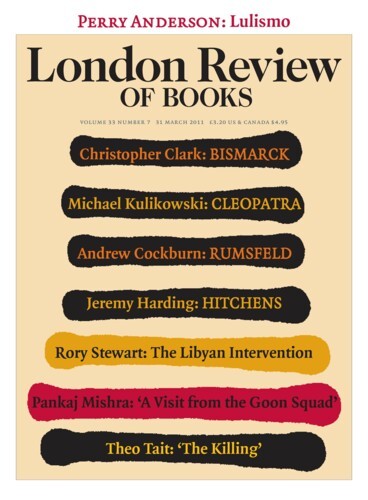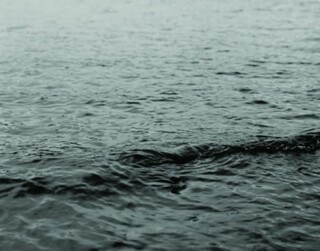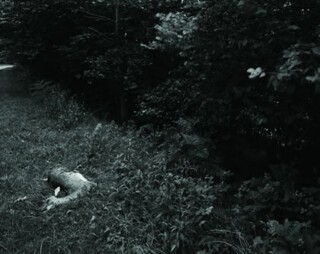‘About twelve noon on 13 November 1951, at a distance of about 200 yards, two distinct humps … something like a couple of ducks, not anything like a porpoise, or a walrus, or a whale, which have been suggested.’ Accounts of sightings of the Loch Ness monster, which provide one wryly mediated source for the Irish artist Gerard Byrne’s exhibition at the MK Gallery in Milton Keynes (until 3 April), have about them something of the cloud-spotting interlude between Hamlet and Polonius (‘’Tis like a camel, indeed … Or like a whale? … Very like a whale’). Since the early 1930s, when the first reported sighting of the legendary beast appeared in the Daily Mail, eyewitness accounts have been a matter of metaphoric feint and slither. The creature seems to be composed entirely of similes and insistent but slippery distinctions – it has its enigmatic pop-cultural being only when compared or contrasted with something else.
Byrne has been mining the Nessie archive for a decade now. The current show brings together for the first time the works he’s previously made about the monster, and adds some new ones. The whole project – here given the deadpan title Case Study: Loch Ness (Some Possibilities and Problems), 2001-11 – is the most frankly comic strand in Byrne’s work, which always hovers between conceptual nous and sheer absurdism.
Byrne is best known for multi-screen video installations that translate published texts into awkward, anachronistic dramas. Why It’s Time for Imperial, Again (1998) puts an already ludicrous 1980 advertorial dialogue between Frank Sinatra and the Chrysler mogul Lee Iacocca into the mouths of two middle-aged actors wandering the run-down streets of Long Island City. In 1984 and Beyond (2005-07) a group of Dutch actors of varying abilities perform the text, published in Playboy in 1963, of a roundtable discussion between 12 science-fiction writers concerning the cultural, political and technological changes they expected to have taken place by the last decades of the century. Much of Byrne’s art is about being out of time, conjuring a historic moment that might have been.
It’s also about word and image, and especially the vexed relay between written and photographic evidence. Loch Ness may seem a whimsical subject for an artist whose source material has recently included psychiatric reports on Nazi war criminals and interviews from the 1960s with Minimalist artists, but it’s worth considering the machinery of print and picture by which the monster first breached the media surface. Two sightings from 1933 are notably indebted to the technologies of tourism: they were reported by a couple in a motor car and a motorcyclist respectively. In August that year the Daily Mirror noted that the loch was ‘becoming famous as the supposed abode of a dragon’. On 21 April 1934, the Mail published the notorious ‘surgeon’s photograph’, said to have been taken by a London gynaecologist called Robert Kenneth Wilson. (It’s still the best-known image: something like Rod Hull’s Emu in grainy profile.) The monster’s celebrity is bound up with the rise of tabloids and motor trips; as Byrne notes in a video interview shown in the gallery foyer, the loch is a ‘cardinal site’ for the involution of photography, truth and fabrication.
All of this is playfully explored in a black and white film that matches the artist’s footage of the loch and its environs with an actor’s solemn intonation of Nessie-spotters’ reports. The latter are full of markers of precision, aspiring to the status of evidence: ‘11.45 a.m. on 22 June 1971 … three dark humps in the water at a distance of 300 yards … 30 September 1965 at about 6.45 a.m… . inconclusive because of the distance of object from camera: 3874 feet.’ But the descriptions of shapes seen in the water are comically, sometimes poetically, figurative: ‘A floating island … goat-like in appearance … the eyes mere slits, similar to the eye of a darning needle … a swelling resembling a fowl with a full crop … misperception of a young roe deer … it had the gait of an elephant, but looked like a cross between a very large horse and a camel.’ The Loch Ness myth, it’s clear, has been conjured out of a touching combination of geekish rigour and interpretative delirium.
Byrne’s own imagery provides a laconic gloss on the descriptive excesses of the monster’s fans. Time and again the sightings involve two or three indistinct ‘humps’, and the film proposes increasingly jocose rhymes between these inchoate verbal objects and all manner of stuff that Byrne discovers around the loch: a pair of owls, a huddle of sheep, some impassive bulls and even a couple of caravans whose curved roofs rise out of the bushes like the fat meanders of a serpentine body. At one point a battered model of the celebrated cryptid itself drifts across the screen to remind us that the creature exists in two distinct guises in the public imagination: one a succession of murky snapshots and shaky Super-8 film footage, the other a long-necked friendly reptile with very often the trace of a grin around its cartoon maw.
This would all amount merely to a diverting exposé of a long-running cultural-scientific curio were it not for Byrne’s reflections on the conventions of photographic reportage and (more interestingly) on the place of the landscape image in contemporary conceptual art. There are hints in his black and white photographs that something more is being attempted by the shores of the loch than just a knowing look at the eccentricities of Nessie-hunters. One room of the gallery is devoted to photographs of mysterious eddies in the water, half-submerged tree trunks that resemble lurking monsters, whorls of plastic piping that look like beached water serpents, a tiny raised swimmer’s arm in the centre of the loch that recalls both the ‘surgeon’s photograph’ and the bathetic, unnoticed splashdown in Pieter Brueghel’s Landscape with the Fall of Icarus. But the humour also evokes more recent art: these edgeland artefacts and events might easily have been photographed by Robert Smithson on his excursions to post-industrial New Jersey in the late 1960s, or by Richard Long on his spectral trails through Britain in the following decades.
In fact, the work of Long and other British walking-artists such as Hamish Fulton is an insistent presence in the exhibition, nowhere more clearly than in the show’s major sculptural element. A massive tree stump sits on the gallery floor, shedding bits of friable Beuys-ish bark. Its smooth, sawn upper surface – which recalls the cutaway redwood tree marked with a timeline in Hitchcock’s Vertigo and its Parisian twin in Chris Marker’s La Jetée – is dotted with pins, and the notional map this suggests projected onto an adjacent wall, the ghostly tree rings traced in graphite. Corresponding to the placements of the pins, fragments of text from the history of the loch are printed in red and black on the wall: ‘a floating telegraph pole … the head was like a terrier’s … none of the witnesses had seen anything quite like it before.’ The typeface used is the one favoured by Fulton in his own works.
Byrne is not exactly satirising the journeys and documentation of artists such as Long and Fulton. (His own works include a literal series of photographs taken in the Dublin mountains and entitled A Country Road, a Tree, Evening – a straight but oddly theatrical invocation of the opening stage direction in Waiting for Godot.) Rather, he’s pointing out in his usual mischievous fashion that the protocols devised by contemporary artists – the photograph presented seemingly as mute evidence, brushing up enigmatically against textual addenda – are not so far removed from the habits of the eccentrics and hobbyists they might encounter in the landscape, or so different from the ruses of the popular press. The legend of the Loch Ness monster is an object lesson in the complex relation of word to image: Nessie after all was born in the age of mechanical reproduction.
Send Letters To:
The Editor
London Review of Books,
28 Little Russell Street
London, WC1A 2HN
letters@lrb.co.uk
Please include name, address, and a telephone number.



